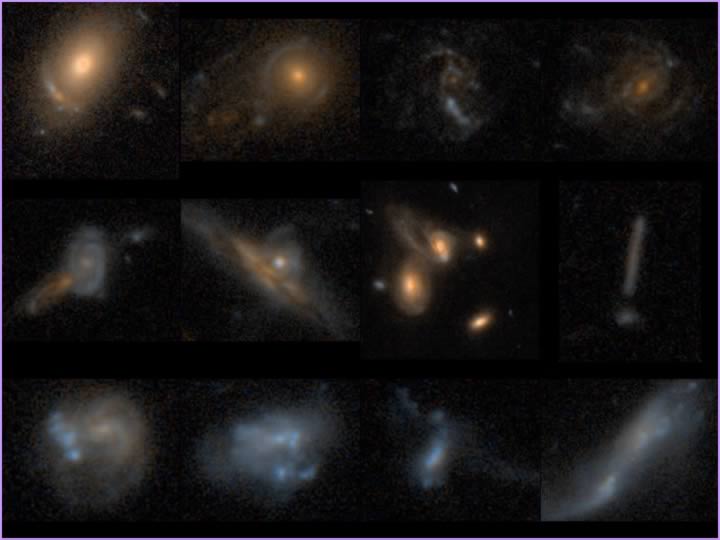 |
 |
Mosaic of AEGIS galaxy images from HST / ACS showing unusual galaxies If the previous image was a family portrait of normal galaxies, these galaxies here are the oddball uncles. In the top row, we have two red elliptical galaxies that appear to have blue rings around them. These rings are called "Einsteing Rings" and are examples of gravitational lenses, where light from a large foreground galaxy acts as a lens, bending the trajectory of the light from a distant galaxy behind it. If the mass of the foreground galaxy is evenly distributed, the lensing effect produces a ring such as these here. If the mass distribution of the foreground galaxy is uneven, it produces instead an "Einsteind Cross", such as the one shown in the previoue image. The two galaxies at the right end of the top row have patchy and irregular spiral arms with unusually compact and red central bulges for such whispy spirals, which suggests that these galaxies have recently been perturbed by an interaction with another galaxy. The middle row of galaxies shows pairs or groups of galaxies that are likely in the process of merging. The two galaxies in the left-most image may be genuinely interacting galaxies, or they may merely be galaxies that are superimposed along the same sightline but that are separated by hundreds of millions of lightyears. The two sets of galaxies in the center of the row show more clear-cut signs of interaction. In the second panel from the left, a small blue spiral galaxy appears to be colliding with a larger spiral galaxy seen edge-on. The edge-on spiral contains a dark band of dust indicating the presence of a dusty disk. The dust in the disk also acts to redden the galaxy starlight, making it appear redder than its companion. Right where the two galaxies seem to intersect, there is a bright point of light. This bright point may be a central burst of star formation triggered by the collision between the two galaxies, or possibly a massive black hole that is gobbling up the gas that has been funneled to the center of the galaxy by the collision. In the image second from the right, the two largest galaxies are clearly interacting. One of the spiral arms of the upper galaxy has been distorted toward the lower galaxy by the strong tidal forces of the interaction. These tidal distortions of galaxies are a dead give-away that a galaxy collision is underway. The galaxies in the bottom row all have irregular, clumpy shapes---the bright blue clumps are knots of star formation. The second image from the right shows the classic tidal tails that are produced in the merger of two spiral galaxies, and the image at the far right also seems to be two galaxies that are in the process of merging. The star formation in the galaxies at the left of the row may have also been triggered by mergers, or possibly by the perturbation of near miss with another galaxy. |